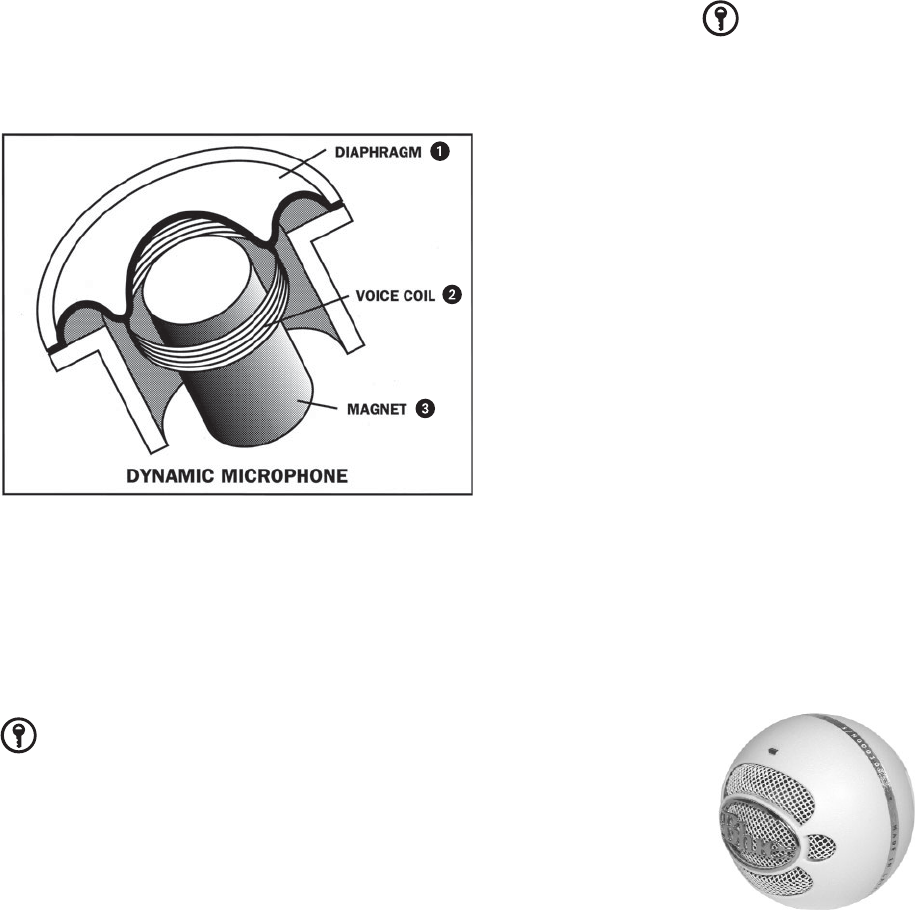
Mic Type and Construction
Microphone types or models are families of microphones that share a means
of construction and accompanying acoustic characteristics. The two most
common types are dynamic and condenser mics, although ribbon mics are
popular for recording as well. Traditionally, dynamic mics have been more
affordable, but today many high-quality condenser mics compete even in
the sub-$200 range; ribbon mics almost always command a higher price.
Because different mic designs produce various trade-offs, there’s no perfect
mic: even beginners should consider assembling a small “mic cabinet” of
models for maximum flexibility and creative options. Typically, this would
include at least a matched pair for stereo recording and a combination of
condenser and dynamic mics. Even two or three good mics will provide
additional choices for recording.
Needless to say, this isn’t just “buying advice.” Once you have several
microphones to choose from, you’ll regularly select certain microphones
for different applications, so knowledge of mic types is critical to creating
the recording you want.
Tip: Starter mic ideas
A great recording can begin with relatively inexpensive mics; two matched dynamic
mics and a condenser mic would be a good starting point. Here are some typical
examples, although there are many options:
Dynamic:
Shure SM57 / 58 / Beta 58 ($80–150 street), Blue The Ball or USB-compati-
ble Blue Snowball ($100–150)—Ideal for drums, vocals, onstage
Condenser:
Røde NT-1A ($200, shown), Studio Projects C1 ($200)—Ideal for vocals,
instruments
Dynamic
Dynamic mics use a moving magnetic coil to produce voltage (Figure 6.5),
so they’re sometimes called moving-coil mics. They operate on the principle
that any coil moving perpendicular to a magnetic field will create current, a
process called electromagnetic induction. The fact that they require a physical
coil to be moved is their primary advantage and disadvantage: dynamics are
unusually resistant to air pressure and are the most rugged mics, but they’re
not as good at picking up high frequencies.
164
C
HAPTER
6: R
ECORDING
I
NSTRUMENTS AND
S
OUND

If you want a mic that can take some physical abuse or record loud sources,
make sure you use a dynamic mic. You’ll find it’s invaluable for many other
recording applications, too, which is why you won’t find a pro studio in the
world without an SM57 on hand.
Genre-bending mics:
You can’t rely on rigid categories to understand micro-
phones, because engineers are always breaking the rules. Case in point: Blue makes
popular, powered dynamic mics like the USB-connected Snowball (pictured, courtesy
Blue Microphones), an exception to the “rule” that dynamics don’t need to be powered
(see sidebar “Phantom Power”, p. 167). By powering the mic, engineers are able to mix
desirable qualities of condensers and dynamics, and make a mic that can be used in
a wider variety of recording situations.
Figure 6.5
Inside the
dynamic capsule.
(Illustration cour-
tesy Shure, Inc.)
A light, thin diaphragm (usually Mylar) is displaced by air
pressure created by sound waves.
A coil of wire attached to the diaphragm moves as the
diaphragm moves.
As the coil of wire moves it disrupts a fixed magnetic field,
generating current, which is fed out of the mic as output
signal.
Dynamic examples:
Shure SM57/58,
Sennheiser MD421 mk II
(shown at the bottom
of p. 164, courtesy
Sennheiser Electronic
Corporation)
Needs power?
No
Pros:
Rugged, wide
amplitude range, often
more affordable
Cons:
Not as good at
capturing high frequen-
cies, tend to “bias” low-
end, produce a weaker
signal
Best for:
General-
purpose recording, loud
recordings like drums
and guitar amps,
onstage applications
165
M
ICROPHONE
C
HARACTERISTICS
Get Real World Digital Audio now with the O’Reilly learning platform.
O’Reilly members experience books, live events, courses curated by job role, and more from O’Reilly and nearly 200 top publishers.

